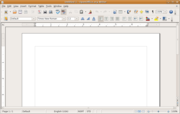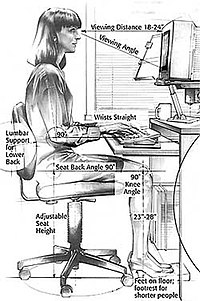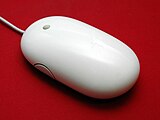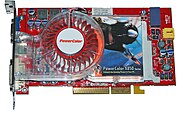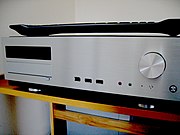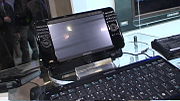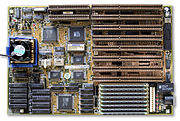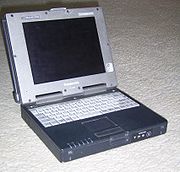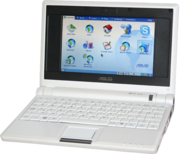
Updated:06/2009
Home > Buyers' Guide > Laptop
Laptop Computer Buying guide
The dooyoo guide to trends in notebook and laptop computers 2009
The dooyoo guide to trends in notebook and laptop computers 2009 - With ever increasing processor speeds, larger hard drive and wireless connectivity, the latest laptop computers offer unprecedented flexibility and computing power. This guide aims to help you select a model that is right for you depending on your computing needs.
Whether you are looking for a desktop replacement with multimedia functionality, a simple budget model, or an ultra light netbook as mobile as you are, dooyoo's buying guide will help you make the right choice. We will cover the key points you need to know about processors, screens and memory as well as providing an overview of trends and developments featured in the latest machines from Acer, Sony, Toshiba, Samsung, Hewlett Packard and Lenovo to mention but a few.
The dooyoo website combines consumer reviews and price comparison in an intelligent mix. We offers tests, opinions and the best prices all in one place and constantly updated. We show you current products and offer advice and information on selection and purchase.
Laptop Computer Buying guide
Sony Vaio CS11Z/RSony Vaio CS11Z/R

hot tipSony VAIO CS11Z/R Notebook for £ 789.95 at Laptops.IM
Sony VAIO VGN-CS11Z / Laptop /R - Core 2 Duo P8400 / 2.26 GHz - Centrino 2 - RAM 4 GB - HDD 320 GB - DVD±RW (±R DL) / DVD-RAM / BD-ROM - GF 9300M GS - WLAN : 802.11 a/b/g/n (draft), Bluetooth 2.1 EDR - Vista Home Premium - 14.1" Widescreen TFT 1280 x 800 ( WXGA ) X-black - camera - Discover a new wo...
Be the first to write a review!
HP De-Branded Sempron LE-1250 2.2GHz 2GB 320GB DVD±RW No Operating System

Fast and affordable, this HP De-Branded Desktop PC is for you! Powered by an AMD Sempron LE-1250 2.2 GHz processor and 2 GB DDR2 RAM, this HP De-Branded Desktop PC features a high capacity 320 GB SATA hard drive and a DVD±RW drive.
Surf the net and download files with the 56K modem and integrated Ethernet. Expand with one PCI Express x16 slot, one PCI Express x1 slot and two PCI slots. Connect a digital camera, DV camcorder and other PC peripherals with USB 2.0 ports, 15-pin VGA monitor port and audio ports.
A mouse and keyboard are already included with this HP De-Branded Desktop PC. Just add the monitor and peripherals, install the operating system and drivers and enjoy fast computing.
WARNING: The solder used in this product contains lead, a chemical known to the State of California to cause birth defects and other reproductive harm. Please wash hands after handling internal components and circuit boards and avoid inhalation of fumes if heating the solder.
Features/Specifications:
* HP De-Branded Sempron LE-1250 2.2 GHz Desktop PC
* General Features:
* No Operating System
* AMD Sempron LE-1250 2.2 GHz processor
* 2 GB DDR2 RAM
* 320 GB SATA hard drive
* DVD±RW drive
* Integrated video
* Integrated audio
* Integrated Ethernet
* 56K PCI modem
* Motherboard Features:
* One (1) PCI Express x16 slot
* One (1) PCI Express x1 slots
* Two (2) PCI slots
* Two (2) 240-pin DIMM sockets
* Front I/O Ports:
* Headphone jack
* Microphone jack
* Two (2) USB 2.0 ports
* Rear I/O Ports:
* Two (2) PS/2 ports
* One (1) 15-pin VGA port
* Four (4) USB 2.0 ports
* One (1) RJ-45 Ethernet jack
* One (1) RJ-11 modem jack
* Line-in, line-out and microphone audio jacks
* Case Features:
* Two (2) 5.25-inch external drive bays
* One (1) 3.5-inch internal drive bay
* 100 - 240V, 50/60Hz power supply
* Case Dimensions:
* 14.75 x 6.5 x 16-inches (H x W x D, approximate)
Package Includes:
* HP De-Branded Sempron LE-1250 2.2 GHz Desktop PC
* Keyboard
* Mouse
* Power cord
HSE stolen laptop contains personal financial data

The laptop containing the data was one of 15 computers stolen from HSE offices in Roscommon town at the weekend.
The office of the Data Protection Commissioner was not informed of the incident by the HSE. It learned of the theft via media reports yesterday morning. It was at that point that the commissioner’s staff contacted the HSE seeking information.
The deputy data protection commissioner, Gary Davis, told The Irish Times he was “surprised and disappointed” at the HSE’s delay in reporting the matter. Mr Davis said the HSE had been at the centre of a number of cases last September in which data was lost on computers and other devices.
Despite assurances from the HSE’s chief executive Prof Brendan Drumm at that time that all computers would be encrypted, the incident at the weekend showed this had not happened.
“Protocols have been broken here and we are carrying out our own investigation,” Mr Davis said.
His agency had legal powers of enforcement involving a fine of €3,000 in all cases where data was lost or computers not encrypted. This avenue might now be explored in relation to the HSE.
A spokeswoman for the HSE said the executive had been waiting for an incident report to be compiled by its staff before informing the commissioner’s office.
One of the two non-encrypted laptops contained sensitive personal financial information on members of the public who had contacted community welfare officers. The second non-encrypted laptop contained slides for a staff presentation, which did not contain sensitive information. The other 13 laptops stolen were encrypted and could not be accessed by whoever stole them.
Toshiba Tecra M10-S3411

For security-minded business users, this Tecra packs plenty of features for a very affordable price. Just don’t expect to wow anyone in the boardroom.
Applications
Application software employs the capabilities of a computer directly and thoroughly to a task that the user wishes to perform. This should be contrasted with system software which is involved in integrating a computer's various capabilities, but typically does not directly apply them in the performance of tasks that benefit the user. In this context the term application refers to both the application software and its implementation. A simple, if imperfect analogy in the world of hardware would be the relationship of an electric light bulb (an application) to an electric power generation plant (a system). The power plant merely generates electricity, not itself of any real use until harnessed to an application like the electric light that performs a service that benefits the user.
Typical examples of software applications are word processors, spreadsheets, and media players. Multiple applications bundled together as a package are sometimes referred to as an application suite. Microsoft Office and OpenOffice.org, which bundle together a word processor, a spreadsheet, and several other discrete applications, are typical examples. The separate applications in a suite usually have a user interface that has some commonality making it easier for the user to learn and use each application. And often they may have some capability to interact with each other in ways beneficial to the user. For example, a spreadsheet might be able to be embedded in a word processor document even though it had been created in the separate spreadsheet application.
End-user development tailors systems to meet the user's specific needs. User-written software include spreadsheet templates, word processor macros, scientific simulations, graphics and animation scripts. Even email filters are a kind of user software. Users create this software themselves and often overlook how important it is.
Selengkapnya......Mac OS X
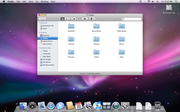
Mac OS X is a line of graphical operating systems developed, marketed, and sold by Apple Inc.. Mac OS X is the successor to the original Mac OS, which had been Apple's primary operating system since 1984. Unlike its predecessors, Mac OS X is a Unix-based operating system.
Operating system
An operating system (OS) manages computer resources and provides programmers with an interface used to access those resources. An operating system processes system data and user input, and responds by allocating and managing tasks and internal system resources as a service to users and programs of the system. An operating system performs basic tasks such as controlling and allocating memory, prioritizing system requests, controlling input and output devices, facilitating computer networking and managing files.
Common contemporary desktop OSes are Microsoft Windows (~91% market share)[22], Mac OS X (~8%)[23], Linux (0.7%), Solaris and PC-BSD. Windows, Mac, and Linux all have server and personal variants. With the exception of Microsoft Windows, the designs of each of the aforementioned OSs were inspired by, or directly inherited from, the Unix operating system. Unix was developed at Bell Labs beginning in the late 1960s and spawned the development of numerous free and proprietary operating systems.
[edit] Microsoft Windows
Microsoft Windows is the name of several families of software operating systems by Microsoft. Microsoft first introduced an operating environment named Windows in November 1985 as an add-on to MS-DOS in response to the growing interest in graphical user interfaces (GUIs).[24][25] The most recent client version of Windows is Windows Vista and the current server version is Windows Server 2008. A new version, Windows 7, is currently in development and is available as a Release Candidate. [26]
[edit] Linux
Linux is a family of Unix-like computer operating systems. Linux is one of the most prominent examples of free software and open source development: typically all underlying source code can be freely modified, used, and redistributed by anyone.[27] The name "Linux" comes from the Linux kernel, started in 1991 by Linus Torvalds. The system's utilities and libraries usually come from the GNU operating system, announced in 1983 by Richard Stallman. The GNU contribution is the basis for the alternative name GNU/Linux.[28]
Predominantly known for its use in servers, Linux is supported by corporations such as Dell, Hewlett-Packard, IBM, Novell, Oracle Corporation, Red Hat, Canonical Ltd. and Sun Microsystems. It is used as an operating system for a wide variety of computer hardware, including desktop computers, supercomputers,[29] video game systems, such as the PlayStation 3, several arcade games, and embedded devices such as mobile phones, routers, and stage lighting systems.
Selengkapnya......Software
Computer software is a general term used to describe a collection of computer programs, procedures and documentation that perform some tasks on a computer system.[21] The term includes application software such as word processors which perform productive tasks for users, system software such as operating systems, which interface with hardware to provide the necessary services for application software, and middleware which controls and co-ordinates distributed systems.
Software applications for word processing, Internet browsing, Internet faxing, e-mail and other digital messaging, multimedia playback, computer game play and computer programming are common. The user of a modern personal computer may have significant knowledge of the operating environment and application programs, but is not necessarily interested in programming nor even able to write programs for the computer. Therefore, most software written primarily for personal computers tends to be designed with simplicity of use, or "user-friendliness" in mind. However, the software industry continuously provide a wide range of new products for use in personal computers, targeted at both the expert and the non-expert user Selengkapnya......Other components
All computers require either fixed or removable storage for their operating system, programs and user generated material.
Formerly the 5 1/4 inch and 3 1/2 inch floppy drive were the principal forms of removable storage for backup of user files and distribution of software.
As memory sizes increased, the capacity of the floppy did not keep pace; the Zip drive and other higher-capacity removable media were introduced but never became as prevalent as the floppy drive.
By the late 1990s the optical drive, in CD and later DVD and Blu-ray Disc, became the main method for software distribution, and writeable media provided backup and file interchange. Floppy drives have become uncommon in desktop personal computers since about 2000, and were dropped from many laptop systems even earlier. [20]
Early home computers used compact audio cassettes for file storage; these were at the time a very low cost storage solution, but were displaced by floppy disk drives when manfacturing costs dropped, by the mid 1980s.
A second generation of tape recorders was provided when Videocassette recorders were pressed into service as backup media for larger disk drives. All these systems were less reliable and slower than purpose-built magnetic tape drives. Such tape drives were uncommon in consumer-type personal computers but were a necessity in business or industrial use.
Interchange of data such as photographs from digital cameras is greatly expedited by installation of a card reader, which often is compatible with several forms of flash memory. It is usually faster and more convenient to move large amounts of data by removing the card from the mobile device, instead of communicating with the mobile device through a USB interface.
A USB flash drive today performs much of the data transfer and backup functions formerly done with floppy drives, Zip disks and other devices. Main-stream current operating systems for personal computers provide standard support for flash drives, allowing interchange even between computers using different processors and operating systems. The compact size and lack of moving parts or dirt-sensitive media, combined with low cost for high capacity, have made flash drives a popular and useful accessory for any personal computer user.
Selengkapnya......Mouse
A Mouse on a computer is a small, slidable device that users hold and slide around to point at, click, and sometimes drag objects on screen in a graphical user interface using a pointer on screen. Almost all Personal Computers have mice. It may be plugged into a computer's rear mouse socket, or as a USB device, or, more recently, may be connected wirelessly via a USB antenna or Bluetooth antenna. In the past, they had a single button that users could press down on the device to "click" on whatever the pointer on the screen was hovering over. Now, however, many Mice have two or three buttons; a "right click" function button on the mouse, which performs a secondary action on a selected object, and a scroll wheel, which users can rotate the wheel using their fingers to "scroll" up or down. The scroll wheel can also be pressed down, and therefore be used as a third button. Different programs make use of these functions differently, and may scroll horizontally by default with the scroll wheel, open different menus with different buttons, among others.
Mice traditionally detected movement and communicated with the computer with an internal "mouse ball"; and use optical encoders to detect rotation of the ball and tell the computer where the mouse has moved. However, these systems were subject to low durability and accuracy. Modern mice use optical technology to directly trace movement of the surface under the mouse and are much more accurate and durable. They work on a wider variety of surfaces and can even operate on walls, ceilings or other non-horizontal surfaces.
Selengkapnya......Keyboards
In computing, a keyboard is an arrangement of buttons that each correspond to a function, letter, or number. They are the primary devices of inputing text. In most cases, they contain an aray of keys specifically organized with the corresponding letters, numbers, and functions printed or engraved on the button. They are generally designed around an operators language, and many different versions for different languages exist. In English, the most common layout is the QWERTY layout, which was originally used in typewriters. They have evolved over time, and have been modified for use in computers with the addition of function keys, number keys, arrow keys, and OS specific keys. Often, specific functions can be achieved by pressing multiple keys at once or in succession, such as inputing characters with accents or opening a task manager. Programs use keyboard shotcuts very differently and all use different keyboard shortcuts for different program specific operations, such as refreshing a web page in a web browser or selecting all text in a word processor.
Selengkapnya......Visual display unit

A visual display unit (or monitor) is a piece of electrical equipment, usually separate from the computer case, which displays viewable images generated by a computer without producing a permanent record. The word "monitor" is used in other contexts; in particular in television broadcasting, where a television picture is displayed to a high standard. A computer display device is usually either a cathode ray tube or some form of flat panel such as a TFT LCD. The monitor comprises the display device, circuitry to generate a picture from electronic signals sent by the computer, and an enclosure or case. Within the computer, either as an integral part or a plugged-in interface, there is circuitry to convert internal data to a format compatible with a monitor. The images from monitors originally contained only text, but as Graphical user interfaces emerged and became common, they began to display more images and multimedia content.
Video card
The video card - otherwise called a graphics card, graphics adapter or video adapter - processes and renders the graphics output from the computer to the computer display, also called the visual display unit (VDU), and is an essential part of the modern computer. On older models, and today on budget models, graphics circuitry tended to be integrated with the motherboard but, for modern flexible machines, they are supplied in PCI, AGP, or PCI Express format.
When the IBM PC was introduced, most existing business-oriented personal computers used text-only display adapters and had no graphics capability. Home computers at that time had graphics compatible with television signals, but with low resolution by modern standards owing to the limited memory available to the eight-bit processors available at the time.
Selengkapnya......Hard disk
Mass storage devices store programs and data even when the power is off; they do require power to perform read and write functions during usage. Although semiconductor flash memory has dropped in cost, the prevailing form of mass storage in personal computers is still the electromechanical hard disk.
The disk drives use a sealed head/disk assembly (HDA) which was first introduced by IBM's "Winchester" disk system. The use of a sealed assembly allowed the use of positive air pressure to drive out particles from the surface of the disk, which improves reliability.
If the mass storage controller provides for expandability, a PC may also be upgraded by the addition of extra hard disk or optical disc drives. For example, DVD-ROMs, CD-ROMs, and various optical disc recorders may all be added by the user to certain PCs. Standard internal storage device interfaces are ATA, Serial ATA, SCSI, and CF+ type II in 2005.
Selengkapnya......Main memory

A PC's main memory is fast storage that is directly accessible by the CPU, and is used to store the currently executing program and immediately needed data. PCs use semiconductor random access memory (RAM) of various kinds such as DRAM or SRAM as their primary storage. Which exact kind depends on cost/performance issues at any particular time. Main memory is much faster than mass storage devices like hard disks or optical discs, but is usually volatile, meaning it does not retain its contents (instructions or data) in the absence of power, and is much more expensive for a given capacity than is most mass storage. Main memory is generally not suitable for long-term or archival data storage.
Ultra-Mobile PC
The ultra-mobile PC (UMPC) is a specification for a small form factor tablet PC. It was developed as a joint development exercise by Microsoft, Intel, and Samsung, among others. Current UMPCs typically feature the Windows XP Tablet PC Edition 2005, Windows Vista Home Premium Edition, or Linux operating system and low-voltage Intel Pentium or VIA C7-M processors in the 1 GHz range.
[edit] Home Theater PC
A home theater PC (HTPC) is a convergence device that combines the functions of a personal computer and a digital video recorder. It is connected to a television or a television-sized computer display and is often used as a digital photo, music, video player, TV receiver and digital video recorder. Home theater PCs are also referred to as media center systems or media servers. The general goal in a HTPC is usually to combine many or all components of a home theater setup into one box. They can be purchased pre-configured with the required hardware and software needed to add television programming to the PC, or can be cobbled together out of discrete components as is commonly done with Windows Media Center, GB-PVR, SageTV, Famulent or LinuxMCE.
Selengkapnya......Market and sales
In 2001 125 million personal computers were shipped in comparison to 48 thousand in 1977. More than 500 million personal computers were in use in 2002 and one billion personal computers had been sold worldwide since mid-1970s until this time. Of the latter figure, 75 percent were professional or work related, while the rest sold for personal or home use. About 81.5 percent of personal computers shipped had been desktop computers, 16.4 percent laptops and 2.1 percent servers. United States had received 38.8 percent (394 million) of the computers shipped, Europe 25 percent and 11.7 percent had gone to Asia-Pacific region, the fastest-growing market as of 2002. The second billion was expected to be sold by 2008.[2] Almost half of all the households in Western Europe had a personal computer and a computer could be found in 40 percent of homes in United Kingdom, compared with only 13 percent in 1985.[3]
The global personal computer shipments were 264 million units in the year 2007, according to iSuppli[4], up 11.2 percent from 239 million in 2006.[5]. In year 2004, the global shipments was 183 million units, 11.6 percent increase over 2003.[6] In 2003, 152.6 million computers were shipped, at an estimated value of $175 billion.[7] In 2002, 136.7 million PCs were shipped, at an estimated value of $175 billion.[7] In 2000, 140.2 million personal computers were shipped, at an estimated value of $226 billion.[7] Worldwide shipments of personal computers surpassed the 100-million mark in 1999, growing to 113.5 million units from 93.3 million units in 1998.[8]. In 1999, Asia had 14.1 million units shipped.[9]
As of June 2008, the number of personal computers in use worldwide hit one billion, while another billion is expected to be reached by 2014. Mature markets like the United States, Western Europe and Japan accounted for 58 percent of the worldwide installed PCs. The emerging markets were expected to double their installed PCs by 2013 and to take 70 percent of the second billion PCs. About 180 million computers (16 percent of the existing installed base) were expected to be replaced and 35 million to be dumped into landfill in 2008. The whole installed base grew 12 percent annually.[10][11]
In the developed world, there has been a vendor tradition to keep adding functions to maintain high prices of personal computers. However, since the introduction of One Laptop per Child foundation and its low-cost XO-1 laptop, the computing industry started to pursue the price too. Although introduced only one year earlier, there were 14 million netbooks sold in 2008.[12] Besides the regular computer manufacturers, companies making especially rugged versions of computers have sprung up, offering alternatives for people operating their machines in extreme weather or environments Selengkapnya......History
The capabilities of the personal computer have changed greatly since the introduction of electronic computers. By the early 1970s, people in academic or research institutions had the opportunity for single-person use of a computer system in interactive mode for extended durations, although these systems would still have been too expensive to be owned by a single person. The introduction of the microprocessor, a single chip with all the circuitry that formerly occupied large cabinets, led to the proliferation of personal computers after about 1975. Early personal computers - generally called microcomputers - were sold often in Electronic kit form and in limited volumes, and were of interest mostly to hobbyists and technicians. Minimal programming was done by toggle switches, and output was provided by front panel indicators. Practical use required peripherals such as keyboards, computer terminals, disk drives, and printers. Unlike other hobbyist computers of its day, which were sold as kits; in 1976 Steve Jobs and Steve Wozniak sold the Apple I was a fully assembled circuit board containing about 30 chips. Such that by 1977 Apple Computers introduced the Apple II, as the world’s first personal computer. By 1977, mass-market pre-assembled computers allowed a wider range of people to use computers, focusing more on software applications and less on development of the processor hardware.
Throughout the late 1970s and into the 1980s, computers were developed for household use, offering personal productivity, programming and games. Somewhat larger and more expensive systems (although still low-cost compared with minicomputers and mainframes) were aimed for office and small business use. Workstations are characterized by high-performance processors and graphics displays, with large local disk storage, networking capability, and running under a multitasking operating system. Workstations are still used for tasks such as computer-aided design, drafting and modelling, computation-intensive scientific and engineering calculations, image processing, architectural modelling, and computer graphics for animation and motion picture visual effects.[1]
Eventually the market segments lost any technical distinction; business computers acquired color graphics capability and sound, and home computers and game systems users used the same processors and operating systems as office workers. Mass-market computers had graphics capabilities and memory comparable to dedicated workstations of a few years before. Even local area networking, originally a way to allow business computers to share expensive mass storage and peripherals, became a standard feature of the personal computers used at home.
Selengkapnya......Personal computer
A personal computer (PC) is any general-purpose computer whose size, capabilities, and original sales price make it useful for individuals, and which is intended to be operated directly by an end user, with no intervening computer operator.
As of 2009, a personal computer may be a desktop computer, a laptop computer or a tablet computer. The most common operating systems for personal computers are Microsoft Windows, Mac OS and Linux, while the most common microprocessors are x86-compatible CPUs, ARM architecture CPUs and PowerPC CPUs. Software applications for personal computers include word processing, spreadsheets, databases, Web browsers and e-mail clients, games, and myriad personal productivity and special-purpose software. Modern personal computers often have high-speed or dial-up connections to the Internet, allowing access to the World Wide Web and a wide range of other resources.
A PC may be a home computer, or may be found in an office, often connected to a local area network (LAN). This is in contrast to the batch processing or time-sharing models which allowed large expensive systems to be used by many people, usually at the same time, or large data processing systems which required a full-time staff to operate efficiently.
While early PC owners usually had to write their own programs to do anything useful with the machines, today's users have access to a wide range of commercial and non-commercial software which is provided in ready-to-run form. Since the 1980s, Microsoft and Intel have been dominating much of the personal computer market with the Wintel platform.
Selengkapnya......Variants
In 1985 IBM introduced Baby AT. Soon after all computer makers abandoned AT for the cheaper and smaller Baby AT, using it for computers from the 286 processors to the first Pentiums. These motherboards have similar mounting hole positions and the same eight card slot locations as those with the AT form factor, but are 2" (51 mm) narrower and marginally shorter. The size (220x330 mm) and flexibility of this kind of motherboard were the key to success of this format. While now obsolete, a few computers are still using it, and modern PC cases are generally backwards compatible to fit Baby AT.
In 1995, Intel introduced ATX, a form factor which gradually replaced older Baby AT motherboards. During the late 1990s, a great majority of boards were either Baby AT or ATX. Many motherboard manufacturers continued making Baby AT over ATX since many computer cases and power supplies in the industry were still compatible with AT boards and not ATX boards. Also, the lack of an eighth slot on ATX motherboards kept it from being used in some servers. After the industry adapted to ATX specifications, it became common to design cases and power supplies to support both Baby AT and ATX motherboards.
Selengkapnya......Ergonomics and health
Because of their small and flat keyboard and trackpad pointing devices, prolonged use of laptops can cause repetitive strain injury.[47] Usage of separate, external ergonomic keyboards and pointing devices is recommended to prevent injury when working for long periods of time; they can be connected to a laptop easily by USB or via a docking station. Some health standards require ergonomic keyboards at workplaces.
The integrated screen often causes users to hunch over for a better view, which can cause neck or spinal injuries. A larger and higher-quality external screen can be connected to almost any laptop to alleviate that and to provide additional "screen estate" for more productive work.
A study by State University of New York researchers found that heat generated from laptops can raise the temperature of the scrotum when balancing the computer on one's lap, potentially putting sperm count at risk. The small study, which included little more than two dozen men aged 21 to 35, found that the sitting position required to balance a laptop can raise scrotum temperature by as much as 2.1 °C (3.8 °F). Heat from the laptop itself can raise the temperature by another 0.7 °C (1.4 °F), bringing the potential total increase to 2.8 °C (5.2 °F). However, further research is needed to determine whether this directly affects sterility in men.[48]
A common practical solution to this problem is to place the laptop on a table or desk. Another solution is to obtain a cooling unit for the laptop, these units are usually USB powered consist of a hard thin plastic case housing 1, 2 or 3 cooling fans (the whole thing is designed to sit under a laptop) which results in the laptop remaining cool to the touch, and greatly reduces laptop heat generation. There are several companies which make these coolers.
Heat from using a laptop on the lap can also cause skin discoloration on the thighs Selengkapnya......Disadvantages
Compared to desktop PCs, laptops have disadvantages in the following fields:
[edit] Performance
While the performance of mainstream desktops and laptops is comparable, laptops are significantly more expensive than desktop PCs at the same performance level.[45] The upper limits of performance of laptops are a little bit lower, and "bleeding-edge" features usually appear first in desktops and only then, as the underlying technology matures, are adapted to laptops.
However, for Internet browsing and typical office applications, where the computer spends the majority of its time waiting for the next user input, even netbook-class laptops are generally fast enough.[46] Standard laptops are sufficiently powerful for high-resolution movie playback, 3D gaming and video editing and encoding. Number-crunching software (databases, math, engineering, financial, etc.) is the area where the laptops are at the biggest disadvantage.
[edit] Upgradeability
Upgradeability of laptops is very limited compared to desktops, which are thoroughly standardized. In general, hard drives and memory can be upgraded easily. Optical drives and internal expansion cards may be upgraded if they follow an industry standard, but all other internal components, including the CPU and graphics, are not intended to be upgradeable.
The reasons for limited upgradeability are both technical and economic. There is no industry-wide standard form factor for laptops; each major laptop manufacturer pursues its own proprietary design and construction, with the result that laptops are difficult to upgrade and have high repair costs. With few exceptions, laptop components can rarely be swapped between laptops of competing manufacturers, or even between laptops from the different product-lines of the same manufacturer.
Some upgrades can be performed by adding external devices, either USB or in expansion card format such a PC Card: sound cards, network adapters, hard and optical drives, and numerous other peripherals are available, but these upgrades usually impair the laptop's portability, because they add cables and boxes to the setup and often have to be disconnected and reconnected when the laptop is moved.
Selengkapnya......Advantages
Portability is usually the first feature mentioned in any comparison of laptops versus desktop PCs[40]. Portability means that a laptop can be used in many places—not only at home and at the office, but also during commuting and flights, in coffee shops, in lecture halls and libraries, at clients' location or at a meeting room, etc. The portability feature offers several distinct advantages:
- Getting more done – Using a laptop in places where a desktop PC can't be used, and at times that would otherwise be wasted. For example, an office worker managing his e-mails during an hour-long commute by train, or a student doing her homework at the university coffee shop during a break between lectures.[41]
- Immediacy – Carrying a laptop means having instant access to various information, personal and work files. Immediacy allows better collaboration between coworkers or students, as a laptop can be flipped open to present a problem or a solution anytime, anywhere.
- Up-to-date information – If a person has more than one desktop PC, a problem of synchronization arises: changes made on one computer are not automatically propagated to the others. There are ways to resolve this problem, including physical transfer of updated files (using a USB stick or CDs) or using synchronization software over the Internet. However, using a single laptop at both locations avoids the problem entirely, as the files exist in a single location and are always up-to-date.
- Connectivity – A proliferation of Wi-Fi wireless networks and cellular broadband data services (HSDPA, EVDO and others) combined with a near-ubiquitous support by laptops [42] means that a laptop can have easy Internet and local network connectivity while remaining mobile. Wi-Fi networks and laptop programs are especially widespread at university campuses.[43]
Other advantages of laptops include:
- Size – Laptops are smaller than standard PCs. This is beneficial when space is at a premium, for example in small apartments and student dorms. When not in use, a laptop can be closed and put away.
- Low power consumption – Laptops are several times more power-efficient than desktops. A typical laptop uses 20-90 W, compared to 100-800 W for desktops. This could be particularly beneficial for businesses (which run hundreds of personal computers, multiplying the potential savings) and homes where there is a computer running 24/7 (such as a home media server, print server, etc.)
- Quiet – Laptops are often quieter than desktops, due both to the components (quieter, slower 2.5-inch hard drives) and to less heat production leading to use of fewer and slower cooling fans.
- Battery – a charged laptop can run several hours in case of a power outage and is not affected by short power interruptions and brownouts. A desktop PC needs a UPS to handle short interruptions, brownouts and spikes; achieving on-battery time of more than 20–30 minutes for a desktop PC requires a large and expensive UPS.[44]
Durability

A clogged heatsink on a 2.5 year old laptop.
Due to their portability, laptops are subject to more wear and physical damage than desktops. Components such as screen hinges, latches, power jacks[50] and power cords deteriorate gradually due to ordinary use. A liquid spill onto the keyboard, a rather minor mishap with a desktop system, can damage the internals of a laptop and result in a costly repair. One study found that a laptop is 3 times more likely to break during the first year of use than a desktop.[51]
Original external components are expensive (a replacement AC adapter, for example, could cost $75); other parts are inexpensive—a power jack can cost a few dollars—but their replacement may require extensive disassembly and reassembly of the laptop by a technician. Other inexpensive but fragile parts often cannot be purchased separate from larger more expensive components.[52] The repair costs of a failed motherboard or LCD panel may exceed the value of a used laptop.
Laptops rely on extremely compact cooling systems involving a fan and heat sink that can fail due to eventual clogging by accumulated airborne dust and debris. Most laptops do not have any sort of removable dust collection filter over the air intake for these cooling systems, resulting in a system that gradually runs hotter and louder as the years pass. Eventually the laptop starts to overheat even at idle load levels. This dust is usually stuck inside where casual cleaning and vacuuming cannot remove it. Instead, a complete disassembly is needed to clean the laptop.
Battery life of laptops is limited; the capacity drops with time, necessitating an eventual replacement after a few years.
[edit] Security
Being expensive, common and portable, laptops are prized targets for theft. The cost of the stolen business or personal data and of the resulting problems (identity theft, credit card fraud, breach of privacy laws) can be many times the value of the stolen laptop itself. Therefore, both physical protection of laptops and the safeguarding of data contained on them are of the highest importance.
Most laptops have a Kensington security slot which is used to tether the computer to a desk or other immovable object with a security cable and lock. In addition to this, modern operating systems and third-party software offer disk encryption functionality that renders the data on the laptop's hard drive unreadable without a key or a passphrase.
[edit] Major brands and manufacturers
There is a multitude of laptop brands and manufacturers; several major brands, offering notebooks in various classes, are listed in the box to the right.
The major brands usually offer good service and support, including well-executed documentation and driver downloads that will remain available for many years after a particular laptop model is no longer produced. Capitalizing on service, support and brand image, laptops from major brands are more expensive than laptops by smaller brands and ODMs.
Some brands are specializing in a particular class of laptops, such as gaming laptops (Alienware), netbooks (EeePC) and laptops for children (OLPC).
Many brands, including the major ones, do not design and do not manufacture their laptops. Instead, a small number of Original Design Manufacturers (ODMs) design new models of laptops, and the brands choose the models to be included in their lineup. In 2006, 7 major ODMs manufactured 7 of every 10 laptops in the world, with the largest one (Quanta Computer) having 30% world market share.[53] Therefore, there often are identical models available both from a major label and from a low-profile ODM in-house brand.
Selengkapnya......A size comparison of 3.5" and 2.5" hard disk drives
- Removable media drives – A DVD/CD reader/writer drive is typically standard. CD drives are becoming rare, while Blu-Ray is becoming more common on notebooks[37]. Many ultraportables and netbooks either move the removable media drive into the docking station or exclude it altogether.
- Internal storage – Laptop Hard disks are physically smaller—2.5 inch (60 mm) or 1.8 inch (46 mm) —compared to desktop 3.5 inch (90 mm) drives. Some newer laptops (usually ultraportables) employ more expensive, but faster, lighter and power-efficient Flash memory-based SSDs instead. Currently, 250 to 320 GB sizes are common for laptop hard disks (64 to 128 GB for SSDs).
- Input – A pointing stick, touchpad or both are used to control the position of the cursor on the screen, and an integrated keyboard is used for typing. External keyboard and mouse may be connected using USB or PS/2 (if present).
- Ports – several USB ports, an external monitor port (VGA or DVI), audio in/out, and an Ethernet network port are found on most laptops. Less common are legacy ports such as a PS/2 keyboard/mouse port, serial port or a parallel port. S-video or composite video ports are more common on consumer-oriented notebooks.
A SODIMM memory
- Memory (RAM) – SO-DIMM memory modules that are usually found in laptops are about half the size of desktop DIMMs.[30] They may be accessible from the bottom of the laptop for ease of upgrading, or placed in locations not intended for user replacement such as between the keyboard and the motherboard. Currently, most midrange laptops are factory equipped with 3-4 GB of DDR2 RAM, while some higher end notebooks feature up to 8 GB of DDR3 memory. Netbooks however, are commonly equipped with only 1 GB of RAM to keep manufacturing costs low.
- Expansion cards – A PC Card (formerly PCMCIA) or ExpressCard bay for expansion cards is often present on laptops to allow adding and removing functionality, even when the laptop is powered on. Some subsystems (such as Wi-Fi or a cellular modem) can be implemented as replaceable internal expansion cards, usually accessible under an access cover on the bottom of the laptop. Two popular standards for such cards are MiniPCI and its successor, the PCI Express Mini. [33]
- Power supply – Laptops are typically powered by an internal rechargeable battery that is charged using an external power supply. The power supply can charge the battery and power the laptop simultaneously; when the battery is fully charged, the laptop continues to run on AC power. The charger adds about 400 grams (1 lb) to the overall "transport weight" of the notebook.
- Battery – Current laptops utilize lithium ion batteries, with more recent models using the new lithium polymer technology. These two technologies have largely replaced the older nickel metal-hydride batteries. Typical battery life for standard laptops is two to five hours of light-duty use, but may drop to as little as one hour when doing power-intensive tasks. A battery's performance gradually decreases with time, leading to an eventual replacement in one to three years, depending on the charging and discharging pattern. This large-capacity main battery should not be confused with the much smaller battery nearly all computers use to run the real-time clock and to store the BIOS configuration in the CMOS memory when the computer is off. Lithium-ion batteries do not have a memory effect as older batteries may have. The memory effect happens when one does not use a battery to its fullest extent, then recharges the battery. New innovations in laptops and batteries have seen new possible matchings which can provide up to a full 24 hours of continued operation, assuming average power consumption levels. An example of this is the HP EliteBook 6930p when used with its ultra-capacity battery.
- Video display controller – On standard laptops the video controller is usually integrated into the chipset. This tends to limit the use of laptops for gaming and entertainment, two fields which have constantly escalating hardware demands[34]. Higher-end laptops and desktop replacements in particular often come with dedicated graphics processors on the motherboard or as an internal expansion card. These mobile graphics processors are comparable in performance to mainstream desktop graphic accelerator boards.[35]
Components
The basic components of laptops are similar in function to their desktop counterparts, but are miniaturized, adapted to mobile use, and designed for low power consumption. Because of the additional requirements, laptop components usually are of inferior performance compared to similarly priced desktop parts. Furthermore, the design bounds on power, size, and cooling of laptops limit the maximum performance of laptop parts compared to that of desktop components. [29]
The following list summarizes the differences and distinguishing features of laptop components in comparison to desktop personal computer parts:
- Motherboard – laptop motherboards are highly make and model specific, and do not conform to a desktop form factor. Unlike a desktop board that usually has several slots for expansion cards (3 to 7 are common), a board for a small, highly integrated laptop may have no expansion slots at all, with all the functionality implemented on the motherboard itself; the only expansion possible in this case is via an external port such as USB or a card slot such as PCMCIA. Other boards may have one or more standard, such as ExpressCard, or proprietary expansion slots. Several other functions (storage controllers, networking, sound card and external ports) are implemented on the motherboard.[30]
- Central processing unit (CPU) – Laptop CPUs have advanced power-saving features and produce less heat than desktop processors, but are not as powerful.[31] There is a wide range of CPUs designed for laptops available from Intel (Pentium M, Celeron M, Intel Core and Core 2 Duo), AMD (Athlon, Turion 64, and Sempron), VIA Technologies, Transmeta and others. On the non-x86 architectures, Motorola and IBM produced the chips for the former PowerPC-based Apple laptops (iBook and PowerBook). Some laptops have removable CPUs, although support by the motherboard may be restricted to the specific models.[32] In other laptops the CPU is soldered on the motherboard and is non-replaceable.
Rugged Laptop
A rugged (or ruggedized) laptop is designed to reliably operate in harsh usage conditions such as strong vibrations, extreme temperatures and wet or dusty environments. Rugged laptops are usually designed from scratch, rather than adapted from regular consumer laptop models. Rugged notebooks are bulkier, heavier, and much more expensive than regular laptops[27], and thus are seldom seen in regular consumer use.
The design features found in rugged laptops include rubber sheeting under the keyboard keys, sealed port and connector covers, passive cooling, superbright displays easily readable in daylight, cases and frames made of magnesium alloys or have a magnesium alloy rollcage[28] that are much stronger than plastic found in commercial laptops and solid-state storage devices or hard disc drives that are shock mounted to withstand constant vibrations. Rugged laptops are commonly used by public safety services (police, fire and medical emergency), military, utilities, field service technicians, construction, mining and oil drilling personnel. Rugged laptops are usually sold to organizations, rather than individuals, and are rarely marketed via retail channels Selengkapnya......Netbook
Netbooks are laptops that are light-weight, economical, energy-efficient and especially suited for wireless communication and Internet access[19][20]. Hence the name netbook (as "the device excels in web-based computing performance")[21] rather than notebook which pertains to size[22].
Especially suited for web browsing and e-mailing, netbooks "rely heavily on the Internet for remote access to web-based applications"[21] and are targeted increasingly at cloud computing users who rely on servers and require a less powerful client computer.[23]. While the devices range in size from below 5 inches[24] to over 12[25], most are between 7 and 11 inches and weigh between 2 and 3 pounds[21].
Netbooks have a wide range of light-weight operating systems including Linux and Windows XP[21] rather than more resource-intensive operating systems like Windows Vista as they have less processing power than traditional laptops[ Selengkapnya......

